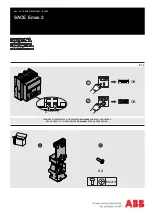
11
10/09 AWB1230-1605
Effective October 2009
Operation and maintenance of
IZM low voltage air circuit breakers
MOELLER
www.moeller.net/de/support
Figure 5. One Side of Drawout Circuit Breaker Properly Seated
on Extension Rail
Adapting cassette
Drawout circuit breaker cassettes are built and shipped in a
“basic” configuration that can be adapted in the field to mate with
specific circuit breakers. Specifically, the rejection interlock must
be configured to the specific circuit breaker to be mated with the
cassette, and the automatic secondary connections may have to
be installed or upgraded. These operations are described in the
following sections.
Rejection interlocks
Within any one physical frame size, IZM drawout circuit
breakers come in a variety of continuous current and interruption
ratings, some of which are incompatible with others. Double-wide
circuit breakers also come with several phase sequence options
that are also incompatible. To prevent the insertion of circuit
breakers with (1) inadequate interrupting capability, (2) with
physically incompatible primary disconnects, or (3) with an
incompatible phase sequence, rejection interlock key plates are
provided on both the circuit breaker and cassette. The key plate on
the circuit breaker is pre-assembled at the factory; but the cassette-
side rejection plate and key pattern must be assembled and installed
by the switchboard builder.
CaUTiOn
DO nOT DiSaBLE rEJECTiOn inTErLOCkS. DOing SO anD USing a
LOWEr CaPaCiTY CirCUiT BrEakEr in an inCOMPaTiBLE CaSSETTE
COULD rESULT in an ELECTriCaL FaULT THaT COULD rESULT in DEaTH,
BODiLY inJUrY, anD/Or EQUiPMEnT DaMagE.
The rejection interlocks are steel pins in the floor of the circuit
breaker cassette. As the circuit breaker is pushed into the structure,
the mating pins on the bottom of the circuit breaker move past a
set of corresponding pins in the cassette if the circuit breaker and
cassette are compatible. If the circuit breaker and the cassette
are mismatched, the rejection pins will block the insertion of the
circuit breaker into the cassette before the levering-in mechanism
is engaged.
Molded Rail Supports
Extension Rail Cutout
Before attempting to push the circuit breaker into the DISCONNECT
position, compare the positioning of rejection interlock pins in the
cassette with
and
and the information supplied on
the circuit breaker’s nameplate. Proceed if the circuit breaker and
cassette are compatible.
Installing secondary jumpers
On drawout circuit breakers, the automatic secondary connector
between the circuit breaker and cassette can be ordered either fully
populated or depopulated (without terminal blocks and jumper wires
installed); these parts can be ordered separately and installed by the
customer. If the necessary connections are not pre-installed, please
contact a Moeller representative for further assistance. These kits
can also be used to add additional secondary wiring to upgrade
circuit breakers in the field.
Installing drawout circuit breaker
In structures equipped for drawout circuit breakers, a bolted-in
cassette with movable extension rails supports the circuit breaker.
The extension rails must first be pulled all the way out. Once the
rails are fully extended, the circuit breaker can be carefully placed
on the extension rails.
CaUTiOn
iT iS iMPOrTanT TO TakE grEaT CarE WHEn PLaCing a DraWOUT
CirCUiT BrEakEr On iTS EXTEnSiOn raiLS. iF THE CirCUiT BrEakEr iS
nOT PrOPErLY SEaTED On THE EXTEnSiOn raiLS, iT COULD FaLL FrOM
THE raiLS, CaUSing EQUiPMEnT DaMagE anD/Or BODiLY inJUrY.
Carefully lower the circuit breaker down onto the extension rails.
Be certain that the circuit breaker’s four molded drawout rail
supports are fully seated in the extension rail cutouts on both
sides (
).
Do not remove the lifting yoke from the
circuit breaker until it is properly seated on the rails.
Once the circuit breaker is on the extension rails and the lifting yoke
is removed, proceed with the rest of the circuit breaker installation.
Figure 6. Cassette Rejection Interlock Pin
Positioning/Installation
From
Table 4
, make a pin location comparison.
Stop nuts should be torqued to 8–10 ft-lb.








































